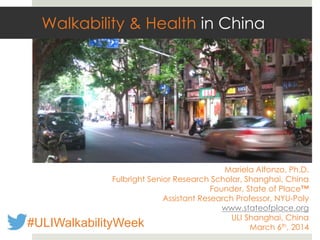
Walkability & Health in China
- 1. Mariela Alfonzo, Ph.D. Fulbright Senior Research Scholar, Shanghai, China Founder, State of Place™ Assistant Research Professor, NYU-Poly www.stateofplace.org ULI Shanghai, China March 6th, 2014 Walkability & Health in China #ULIWalkabilityWeek
- 2. ?
- 4. 0% 20% 40% 60% 80% 100% DENSITY FORM CONNECTIVITY PROXIMITY PARKS & PUBLIC SPACES RECREATIONAL FACILITIES PEDESTRIAN AMENITIES TRAFFIC SAFETY BICYCLE AMENITIES AESTHETICS PERSONAL SAFETY URBAN FABRIC DESTINATIONS HUMAN NEEDS & COMFORT LIVELINESS & UPKEEP State of Place™ Profile
- 5. 0% 20% 40% 60% 80% 100% DENSITY FORM CONNECTIVITY PROXIMITY PARKS & PUBLIC SPACES RECREATIONAL FACILITIES PEDESTRIAN AMENITIES TRAFFIC SAFETY BICYCLE AMENITIES AESTHETICS PERSONAL SAFETY URBAN FABRI C DESTINATIONS HUMAN NEEDS & COMFORT LIVELINESS & UPKEEP State of Place™ Profile
- 6. Density Building concentrations & height
- 9. 0% 20% 40% 60% 80% 100% DENSITY FORM CONNECTIVITY PROXIMITY PARKS & PUBLIC SPACES RECREATIONAL FACILITIES PEDESTRIAN AMENITIES TRAFFIC SAFETY BICYCLE AMENITIES AESTHETICS PERSONAL SAFETY URBAN FABRIC DESTINATIONS HUMAN NEEDS & COMFORT LIVELINESS & UPKEEP State of Place™ Profile
- 10. Proximity Mix of land uses
- 11. Parks & Public Space Parks, playgrounds, plazas
- 12. Recreational Facilities Gyms, fitness centers, outdoor recreation Photo Credit Bill Cotter
- 13. 0% 20% 40% 60% 80% 100% DENSITY FORM CONNECTIVITY PROXIMITY PARKS & PUBLIC SPACES RECREATIONAL FACILITIES PEDESTRIAN AMENITIES TRAFFIC SAFETY BICYCLE AMENITIES AESTHETICS PERSONAL SAFETY URBAN FABRIC DESTINATIONS HUMAN NEEDS & COMFORT LIVELINESS & UPKEEP State of Place™ Profile
- 14. Pedestrian Infrastructure & Amenities Curbcuts, sidewalk buffers, benches
- 15. Bicycle Infrastructure & Amenities Bicycle lanes, buffers, bike racks
- 16. Traffic Safety Traffic signals, speed limit, traffic calming
- 17. 0% 20% 40% 60% 80% 100% DENSITY FORM CONNECTIVITY PROXIMITY PARKS & PUBLIC SPACES RECREATIONAL FACILITIES PEDESTRIAN AMENITIES TRAFFIC SAFETY BICYCLE AMENITIES AESTHETICS PERSONAL SAFETY URBAN FABRIC DESTINATIONS HUMAN NEEDS & COMFORT LIVELINESS & UPKEEP State of Place™ Profile
- 19. Personal Safety Graffiti, litter, windows with bars
- 20. ?
- 21. Walkability
- 22. Walkability
- 23. 1986 2009 SHAREOF TRIPSBYBIKE housing construction18B SQ M 2000 – = 5M 2014 1982 = 3,428 1990 – 2004 BUILT OUT AREA DENSITY Communities 162% 67% 80% 2007 GATE D
- 25. 2004 2010 EMISSION S per capitaCHINA’ SEMISSION RATE 1/3TO P of emitters AIR POLLUTION IN 2010 RESPONSIBLE FOR 1.2 Million DEATHS 8 YOUNGEST LUNG CANCER PATIENT ON RECORD YR S OL
- 26. $18.3B INCOME LOSS of HEART DISEASE, STROKE & DIABETES IN CHINA due to IN 2005 ALONE RESIDEN TS 2.5B 500M YRS LIFE EXPECTANCY IN 2009 9 GROS S NATIONA L DUE TO ENVIRONMENTALLOSS
- 27. State of Place Index: 90, Very High Walkability State of Place Index: 5, Very Low
- 28. + $36 sq ft Office Rents + $28 sq ft Retail Rents +80% Retail Revenues + $1200/Unit Residential Rent +$324 sq ft For-sale Residential Value
- 30. 0% 20% 40% 60% 80% 100% DENSITY FORM CONNECTIVITY PROXIMITY PARKS & PUBLIC SPACES RECREATIONAL FACILITIES PEDESTRIAN AMENITIES TRAFFIC SAFETY BICYCLE AMENITIES AESTHETICS PERSONAL SAFETY State of Place™ ProfileROI HighLowMedium
- 120. U.S. In last decade CHINA has added 2/3 of population will have Chinese cities221 over 1 million ppl By 2025 CHINA NEEDS 170 new mass-transit 5B new sq.m. of roads 40B new sq.m. of floor space
- 122. Shanghai Walk & Talks: www.meetup.com/shanghai-walk-talks www.stateofplace.org #ULIWalkabilityWeek
Editor's Notes
- Introduction
- But also about health
- Found 5 levels of walkability – attached to econ perf
- Found 5 levels of walkability – attached to econ perf
- Socio-cultural status equated with motorized mobility
- Outdated/ill-intentioned codes; LDIs
- Too many ministries/departments involved; goals are not in-sync
- Who takes responsibility? Who is in charge of fixing the problem?
- Tearing down historical districts; getting rid of street food/vending; outlawing sidewalk dining
- Everything has to happen yesterday
- The bigger the project, the better
- Short-term thinking overshadows long-term approach
- Lack of awareness and education
- The idea that nothing can be done; complacency. That’s just the way it is.
